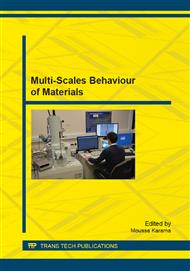p.1
p.12
p.27
p.39
p.51
p.64
p.74
p.83
p.96
Effects of Ageing in Marine Environment on Glass Fibre/Unsaturated Polyester Composite
Abstract:
The aim of this work is the study of the long term behaviour of a laminated composite made in glass/polyester and aged in seawater at various temperatures. The results obtained show that the immersion in seawater causes ageing of the composite material. This was reflected first by a change in color of the material depending on the temperature of the immersion and the gel-coat loses its brightness. The infrared spectroscopy has confirmed activation of chemical degradation (hydrolysis of the resin and of the fibre/matrix interface, fibre degradation). This chemical degradation could be the cause of decrease in strength and ductility detected by analysing the behaviour of immersed testing specimens. It could also be the cause of the increase of absorption rate recorded for immersions exceeding 22 days.
Info:
Periodical:
Pages:
51-63
Citation:
Online since:
December 2011
Price:
Сopyright:
© 2012 Trans Tech Publications Ltd. All Rights Reserved
Share:
Citation:


